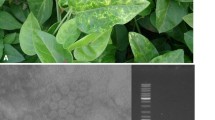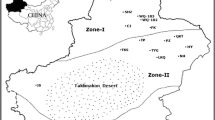Abstract
Saffron (Crocus sativus) is widely used as an important herbal medicine crop worldwide. Iran is the largest producer and exporter of saffron in the world. Turnip mosaic virus (TuMV) is a species of the genus Potyvirus, which infects a wide range of plants species. During the autumn of 2019, saffron plants with symptoms including colour breaking of the flowers, chlorosis and mild mosaic of leaves were collected from the major saffron cultivation areas of Iran. After the isolation of total RNA from diseased samples, RT-PCR was done using TuMV-specific primers. Amplicons of two selected isolates were purified, cloned, and sequenced. BLASTn of obtained sequences indicated high similarity with TuMV sequences. To the best of our knowledge, this is the first finding of TuMV infection in the saffron plant of Iran.


Similar content being viewed by others
References
Ahrazem O, Rubio-Moraga A, Castillo-Lopez R, Trapero-Mozos A, Gómez-Gómez L. Crocus sativus pathogens and defence responses. In: Husaini, A.M. (Ed.), Functional Plant Science and Biotechnology. Special Issue: Saffron. Global Science Books, Ltd., London. 2010; pp. 81–90.
Chen J, Chen JS. Occurrence and control of mosaic disease [Turnip mosaic virus] in saffron (Crocus sativus). Zhejiang Nongye Kexue. 2000;3:132–5.
Grilli Caiola M, Faoro F. Latent virus infections in Crocus sativus and Crocus cartwrightianus. Phytopathol Mediterr. 2011;50(2):175–82.
Ochoa Corona FM, Lebas BSM, Elliott DR, Tang JZ, Alexander BJR. New host records and new host family range for Turnip mosaic virus in New Zealand. Austral Plant Dis Notes. 2007;2:127–30. https://doi.org/10.1071/DN07051.
Moradi Z, Nazifi E, Mehrvar M. Occurrence and evolutionary analysis of coat protein gene sequences of Iranian isolates of Sugarcane mosaic virus. Plant Pathol J. 2017;33(3):296–306. https://doi.org/10.5423/PPJ.OA.10.2016.0219.
Sánchez F, Wang X, Jenner CE, Walsh JA, Ponz F. Strains of Turnip mosaic potyvirus as defined by the molecular analysis of the coat protein gene of the virus. Virus Res. 2003;94(1):33–43. https://doi.org/10.1016/S0168-1702(03)00122-9.
Author information
Authors and Affiliations
Corresponding author
Ethics declarations
Conflicts of interest
The authors declare that they have no conflict of interest.
Additional information
Publisher's Note
Springer Nature remains neutral with regard to jurisdictional claims in published maps and institutional affiliations.
Rights and permissions
Springer Nature or its licensor holds exclusive rights to this article under a publishing agreement with the author(s) or other rightsholder(s); author self-archiving of the accepted manuscript version of this article is solely governed by the terms of such publishing agreement and applicable law.
About this article
Cite this article
Tavoosi, M., Moradi, Z. & Mehrvar, M. First report of Turnip mosaic virus infecting saffron in Iran. VirusDis. 33, 489–491 (2022). https://doi.org/10.1007/s13337-022-00798-4
Received:
Accepted:
Published:
Issue Date:
DOI: https://doi.org/10.1007/s13337-022-00798-4




